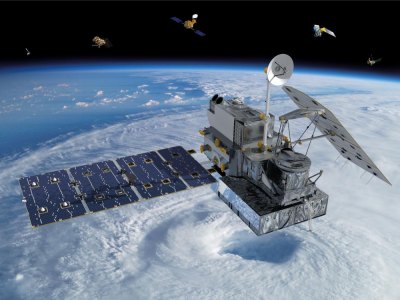NASA In Brief -- Climate satellite launched; companies develop space taxis

The 4-ton satellite launched aboard a Japanese H-IIA rocket from Tanegashima Space Center on Tanegashima Island in southern Japan. The spacecraft separated from the rocket 16 minutes after launch at an altitude of 247 miles (398 kilometers). The solar arrays deployed 10 minutes after separation to power the spacecraft.
The observatory will take a major step in improving the capabilities of the Tropical Rainfall Measurement Mission. While that mission measured precipitation in the tropics, the observatory expands the coverage area from the Arctic Circle to the Antarctic Circle. It will also be able to detect light rain and snowfall, a major source of available fresh water in some regions.
To better understand Earth's weather and climate cycles, the observatory will collect information that unifies and improves data from an international constellation of satellites by mapping global precipitation every three hours.
This is the first of NASA's five Earth science missions launching this year.
SPACE TAXI, PLEASE: NASA's aerospace industry partners continue to meet milestones under agreements with the agency's Commercial Crew Program, as they move forward in their development of spacecraft and rockets that will transport humans to destinations in low-Earth orbit.
Blue Origin, Boeing Space Exploration, Sierra Nevada Corp. and SpaceX each are developing distinct transportation systems, and each faces stringent evaluations and tests in 2014. The Commercial Crew Program’s engineering team is working closely with its partners as they develop the next generation of crewed spacecraft. NASA intends to certify and use these commercial systems to fly astronauts from U.S. soil to the International Space Station and back.
Boeing and Sierra met key milestones in late December and throughout January. Boeing worked with United Launch Alliance to complete milestones in the development of an emergency detection system and launch vehicle adapter for the Atlas V rocket planned to launch Boeing’s CST-100.
The CST-100's emergency detection system is an integrated set of hardware and software that will operate with the avionics systems of the Atlas V rocket as it lifts off and ascends into orbit. In the event of a confirmed emergency, the detection system will send a signal to the CST-100 to trigger escape thrusters on the spacecraft to push the crew out of harm's way and return them safely to Earth.
Engineers ran the software through a series of emergency scenarios to verify the performance of the escape system, carefully tracking how changes in one component might affect another. The launch vehicle adapter that connects the CST-100 to the top of the rocket also received significant attention during the critical design review. Boeing demonstrated that pilots could take control of the CST-100 and fly it through various phases of a mission successfully.
Related:
5 NASA missions probe Earth's climate: A photo gallery
NASA aircraft seeks climate change clues
NASA In Brief -- Technology measure glaciers; telescopes spot distant galaxy

